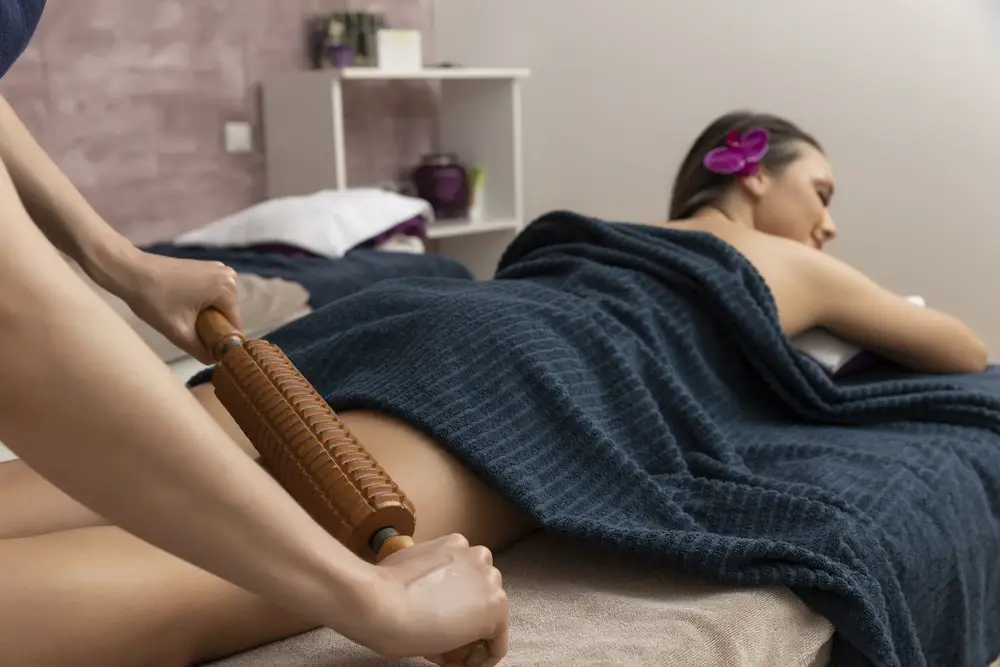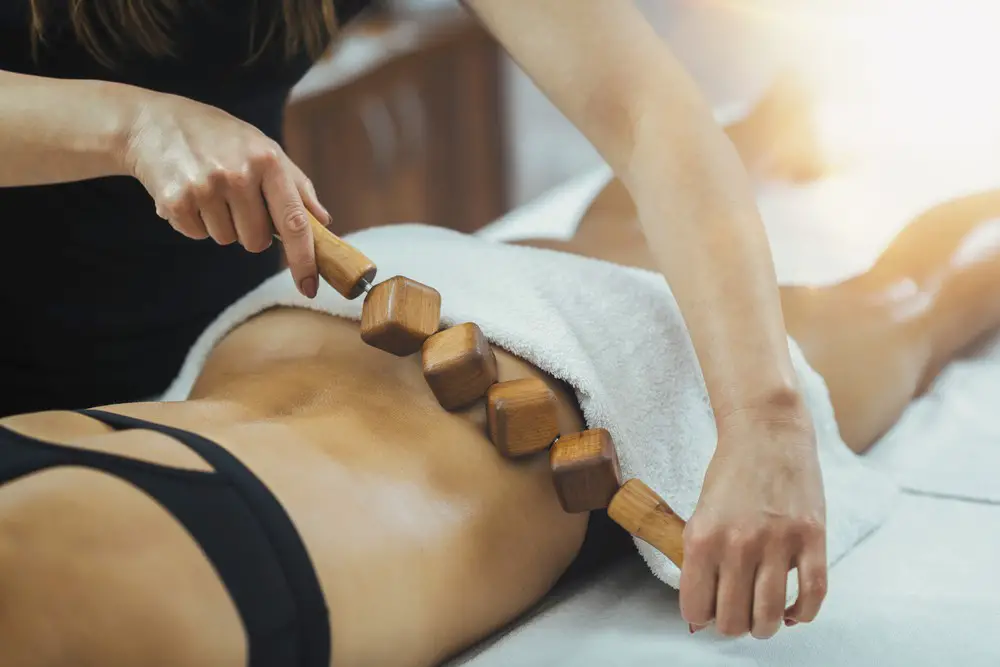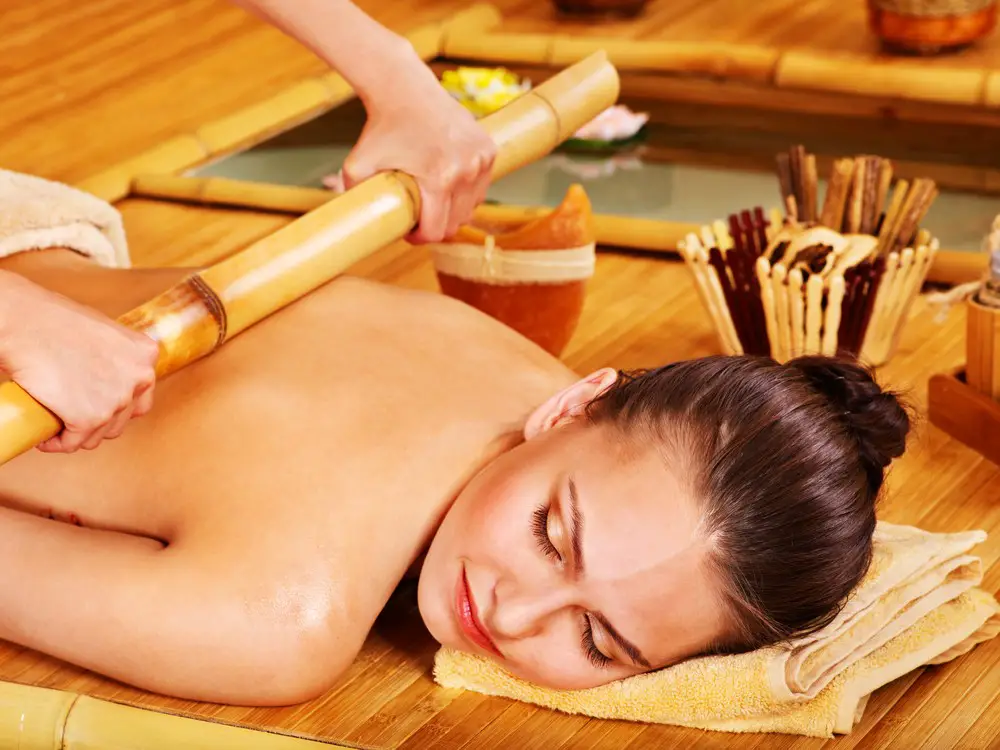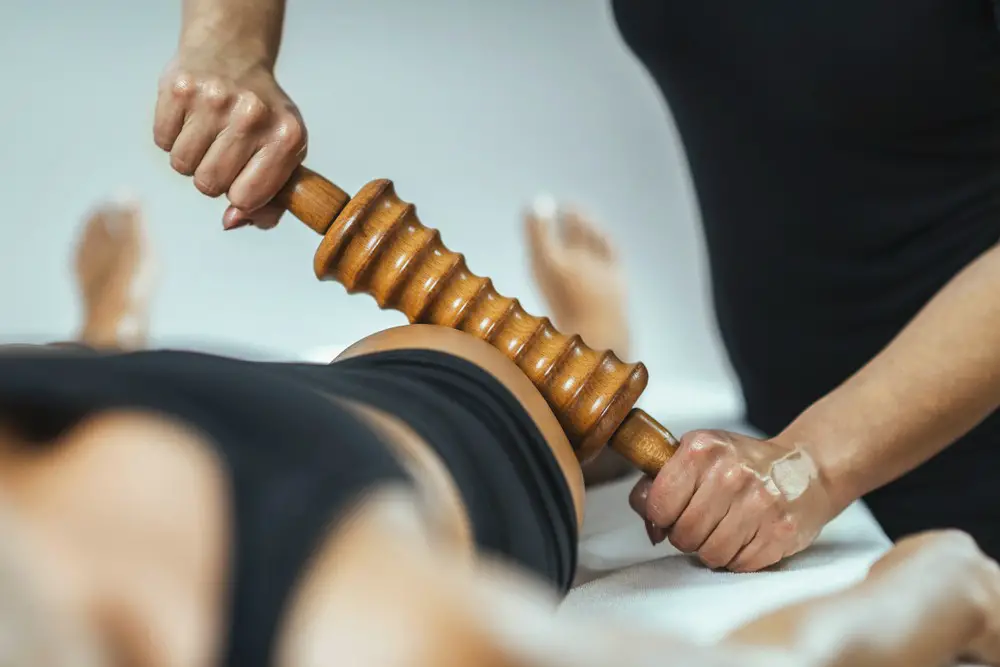As a BetterHelp affiliate, we receive compensation from BetterHelp if you purchase products or services through the links provided
Wood therapy is a unique and natural treatment that has gained popularity for its potential benefits in body contouring and mental health. This therapeutic technique utilizes specialized wooden tools to massage the body, targeting areas of concern such as cellulite, excess body fat, and tension.
In this article, we will investigate wood therapy – from how it works to its many advantages and who can benefit from it – and the preparation for a session and aftercare tips for maximum efficacy. We will also discuss how to prepare for a session and offer aftercare tips to ensure optimal results.
Lastly, finding a qualified wood therapist is crucial for experiencing the full range of wood therapy’s benefits. Stay tuned as we guide you through every aspect of this fascinating practice.
Table Of Contents:
- What is Wood Therapy?
- A Brief Overview of Wood Therapy
- The Origins of Wood Therapy
- How Does Wood Therapy Work?
- Benefits of Wood Therapy
- Who Can Benefit from Wood Therapy?
- Preparing for a Wood Therapy Session
- Aftercare Tips for Wood Therapy Sessions
- Finding a Qualified Wood Therapist
- Incorporating Wood Therapy into Your Self-Care Routine
- Frequently Asked Questions
- Conclusion
What is Wood Therapy?

Wood therapy, also known as maderotherapy or maderoterapia, is a unique and holistic massage technique that utilizes specially designed wooden tools to help alleviate various physical and mental health issues. Originating from ancient Colombian and Asian practices, wood therapy has recently gained popularity for its numerous benefits on the body and mind.
A Brief Overview of Wood Therapy
In wood therapy, practitioners use hand-held wooden instruments with different shapes and sizes to apply pressure on specific body areas. These tools are carefully crafted from natural materials such as cedarwood or oak, ensuring they are eco-friendly and safe for use on the skin.
The primary goal of this therapeutic practice is to stimulate blood circulation, lymphatic drainage, muscle relaxation, cellulite reduction, and stress relief, among other advantages. In addition, the versatility of these wooden tools allows therapists to customize each session according to their client’s needs – making it an ideal choice for people seeking alternative treatments for various ailments.
The Origins of Wood Therapy
Ancient Colombian cultures have long used wood therapy techniques in traditional healing rituals, while similar practices can be traced back thousands of years across Asia. Columbian therapist Elizabeth Vargas developed today’s modern version, who combined her knowledge about traditional methods with contemporary massage techniques, creating a powerful fusion that caters to improving overall well-being.
Eco-Friendly Approach To Massage Therapy
- Natural materials: Wooden tools used in maderotherapy sessions are made from sustainable sources like cedarwood or oak trees, which do not harm the environment.
- Reusable: Unlike other massage tools, wooden instruments can be easily cleaned and reused multiple times, reducing waste.
- Chemical-free: Wood therapy does not require chemicals or synthetic products that may harm the environment or your skin.
Wood therapy, a form of massage treatment utilizing the power of nature to foster physical and mental well-being, offers an eco-friendly approach with a long history as an attractive alternative for those seeking health solutions. It’s eco-friendly approach and rich history make it an attractive option for those seeking alternative therapies for various health concerns.
Wood therapy, a fresh and all-inclusive mental health approach that has recently become increasingly popular, is being looked at more closely. By considering the mechanisms, we can start to evaluate the advantages of this type of therapy for those experiencing various psychological health problems. Moving on, let us now discuss how wood therapy works.
How Does Wood Therapy Work?

Wood therapy, a unique form of massage, utilizes various hand-held wooden tools to manipulate the body’s muscles and tissues. The process involves applying pressure using these specially designed instruments to target specific areas of concern. Let’s delve deeper into the techniques used in wood therapy and how they can benefit individuals with mental health issues.
Techniques Used in Wood Therapy
- Maderoplasty: This technique focuses on contouring the body by breaking down cellulite deposits and stimulating lymphatic drainage. Maderoplasty is particularly helpful for those with stress-related weight gain or poor circulation.
- Cupping: Wooden cups create suction on the skin, which helps increase blood flow and promote relaxation. This method is excellent for relieving tension headaches caused by anxiety or depression. Learn more about cupping here.
- Rolling: A wooden roller is utilized to apply gentle pressure along muscle fibers, releasing tightness and improving flexibility. Rolling can be especially beneficial for individuals experiencing muscle stiffness due to prolonged periods of stress or sitting at a desk all day.
The Role of Hand-Held Wooden Tools
Hand-held wooden tools set wood therapy apart from traditional massage methods that rely solely on manual manipulation by therapists’ hands. These specialized instruments come in various shapes and sizes, each serving a distinct purpose during treatment sessions. For example:
- A round-edged tool may be employed for kneading larger muscle groups like those found in your back;
- A smaller cylindrical instrument might be ideal for targeting pressure points in your neck and shoulders;
- A flat-edged tool can smooth out cellulite deposits or break up scar tissue.
These wooden tools allow therapists to apply more focused pressure and provide a unique sensory experience for clients. In addition, the wooden tools impart a comforting ambiance, which can help to ease stress and cultivate mental well-being through their warmth, texture, and natural energy.
Individuals can reduce stress and improve their well-being by engaging in wood therapy. Next, let’s delve into the advantages of wood therapy in greater depth.
Benefits of Wood Therapy

Wood therapy can promote holistic well-being with physical, mental, and emotional benefits. Let’s explore some of this unique massage technique’s most significant advantages.
Physical Benefits
- Pain Relief: The pressure applied during wood therapy sessions helps release muscle tension and alleviate pain in various body parts. This makes it an excellent option for those suffering from chronic pain or discomfort due to injury or stress (source).
- Lymphatic Drainage: By stimulating the lymphatic system, wood therapy aids in detoxification by promoting proper fluid circulation throughout the body. This can lead to reduced swelling and improved immune function.
- Toning and Sculpting: The wooden tools used in maderotherapy are designed to contour and shape specific areas like thighs, buttocks, arms, or abdomen. As a result, regular sessions may contribute to toning muscles and reducing cellulite appearance (source).
Mental Health Benefits
- Stress Reduction: The relaxing nature of wood therapy helps lower cortisol levels (the stress hormone) while increasing serotonin production (the feel-good hormone). This results in reduced anxiety levels and improved mood stability(source).
- Mental Clarity: By alleviating physical tension, wood therapy allows the mind to relax and focus better. This can lead to improved mental clarity and enhanced cognitive function.
Emotional Benefits
- Sense of Connection: Wood therapy provides a unique opportunity for individuals to connect with nature through natural wooden tools. This connection can foster grounding, balance, and harmony within oneself.
- Increase in Self-esteem: As clients notice improvements in their physical appearance after several sessions, they may experience increased self-confidence and body positivity (source).
The benefits mentioned above make wood therapy an excellent option for those seeking holistic approaches to improve their overall well-being. So whether you’re dealing with chronic pain or simply looking for ways to de-stress and rejuvenate your body, this ancient massage technique might be just what you need.
Wood therapy can benefit those with mental health struggles, such as enhanced spirits and decreased stress. When looking into this type of treatment, who can benefit from wood therapy is an important question.
Who Can Benefit from Wood Therapy?
Wood therapy is a versatile massage technique that can benefit various individuals. Whether dealing with physical discomfort, mental health issues, or simply seeking relaxation and stress relief, wood therapy might be the perfect solution.
Athletes and Fitness Enthusiasts
Athletes and fitness enthusiasts often experience muscle soreness, stiffness, and fatigue due to their intense workout routines. Wood therapy can help alleviate these symptoms by improving blood circulation, reducing inflammation, and promoting faster recovery.
Individuals with Chronic Pain Conditions
If you suffer from chronic pain conditions such as fibromyalgia or arthritis, wood therapy may offer some relief by targeting specific pressure points in your body. In addition, the wooden tools used during the session allow precise manipulation of muscles and joints without causing further irritation or damage.
People Experiencing Stress & Anxiety
- Mental Health: Wood therapy has been found to positively affect mental health by reducing stress levels through deep relaxation techniques.
- Anxiety Relief: The soothing nature of this massage modality can also help those struggling with anxiety find calm amidst their daily struggles.
- Mindfulness Practice: As a form of self-care, wood therapy encourages mindfulness, allowing clients to focus on their present sensations and emotions, promoting overall well-being.
Individuals Seeking Holistic Health Approaches
Wood therapy is an excellent option for those who prefer natural and holistic approaches to health care. Wood therapy is ideal for those seeking a natural and holistic approach to health care as it does not involve chemicals or medications.
In summary, wood therapy can benefit many people with diverse needs. For example, wood therapy may be viable for those seeking to enhance their athletic abilities or manage emotional issues.
Wood therapy may be advantageous for individuals enduring various mental health issues, including but not limited to angst, despondency, and PTSD. Now let’s look at how you can prepare for your wood therapy session.
Preparing for a Wood Therapy Session

You must be well-prepared for the session if you’re considering wood therapy to address your mental health issues. Prepare adequately to make sure you get the maximum advantage from your experience. Here are some tips on how to prepare for a wood therapy session:
Create a Comfortable Environment
Wood therapy is meant to be relaxing and therapeutic, so creating an environment that promotes relaxation is crucial. Ensure the session room has comfortable lighting, soothing colors, and minimal distractions.
Dress Appropriately
Since wood therapy involves direct contact with your skin, wearing loose-fitting clothing or underwear during the treatment is essential. This allows the therapist easy access to different areas of your body without any restrictions from tight clothes.
Stay Hydrated
Proper hydration before and after your session can help improve circulation and aid in flushing toxins from your body more effectively. Drink plenty of water before your appointment, and ensure you have water available afterward.
Eat Lightly Before Your Session
- Avoid heavy meals at least two hours before your appointment – this helps prevent discomfort during treatment due to fullness or bloating.
- Opt for light snacks like fruits or nuts if you need something small before starting.
Talk To Your Therapist About Any Concerns Or Questions You May Have
Your therapist should be knowledgeable about wood therapy techniques and able to address any concerns or questions you may have. Don’t hesitate to ask about the process, tools used, and what to expect during your session.
Practice Relaxation Techniques
Learning how to relax is essential to maximizing the benefits of wood therapy. Consider practicing relaxation techniques, such as deep breathing exercises or meditation, before your appointment – this can help you enter a more relaxed state when it’s time for your session.
By preparing, you can maximize your wood therapy session and experience its full potential of mental health benefits and overall well-being.
Before engaging in wood therapy, taking the necessary steps to ensure a successful session is critical. To ensure that the benefits of wood therapy are sustained, here are some post-treatment guidelines to follow.
Aftercare Tips for Wood Therapy Sessions

After a wood therapy session, following some aftercare tips is essential to maximize the benefits and ensure your body recovers well. Here are some recommendations:
A. Stay Hydrated
Drinking plenty of water is crucial after any massage, including wood therapy. Staying hydrated helps flush out toxins released during the treatment and supports overall health.
B. Rest and Relaxation
Allow your body to reap the full advantages of the wood therapy session by providing some rest afterward. Avoid engaging in strenuous activities or exercise immediately following a wood therapy session.
C. Apply Heat or Cold Packs if Needed
If you experience soreness or discomfort after your treatment, applying heat or cold packs can help alleviate these symptoms by reducing inflammation and promoting relaxation.
D. Follow Your Therapist’s Recommendations
Your therapist may provide specific advice tailored to your needs based on their assessment during the session; be sure to follow their guidance for optimal results.
Eat Healthily & Maintain Balanced Diet
- Incorporate more fruits, vegetables, lean proteins, and whole grains into meals;
- Avoid processed foods high in sugar and unhealthy fats;
- Maintain portion control while eating;
- By adhering closely to these guidelines along with regular wood therapy sessions, you will reap maximum mental health benefits from this holistic approach to wellness.
Aftercare Tips for Wood Therapy Sessions are essential to ensure a successful and beneficial experience. Finding a qualified wood therapist who can provide the necessary support during your sessions.
Finding a Qualified Wood Therapist

Tracking down an adept wood therapist in your locality may seem intimidating. Still, with the correct tools and research, you can find a professional experienced enough to help you gain the advantages of this exceptional treatment. Here are some steps to follow when searching for a wood therapist:
- Ask for recommendations: Reach out to friends, family members, or coworkers who have tried wood therapy before and ask if they can recommend any therapists in your area.
- Research online: Utilize search engines like Google by typing in keywords such as “wood therapy near me” or “maderotherapy practitioners.” This should provide you with local options to explore further.
- Browse directories and review sites: Websites like Yelp or specialized massage directories often contain listings of various types of therapists, including those specializing in wood therapy. These platforms also offer user reviews that can give insight into the quality of service each practitioner provides.
- Contact professional organizations: Get in touch with national or regional associations related to massage therapy (such as the American Massage Therapy Association), which might maintain lists of certified professionals offering specific modalities like maderotherapy.
- Evaluate qualifications and experience: Once you have identified potential therapists, it is essential to verify their credentials. Ensure they hold relevant certifications from recognized institutions, such as training courses accredited by reputable organizations like International MaderoTherapy Institute. Additionally, inquire about their years of experience practicing wood therapy specifically.
- Schedule consultations: Before committing to a therapist, it is advisable to schedule a consultation. This will allow you to discuss your needs and expectations with the practitioner, ensuring they can provide the desired results.
By following these steps, you can find a qualified wood therapist who will help improve your mental health through this unique form of massage therapy. Remember that each individual’s experience may vary, so be open-minded and willing to try different practitioners if necessary until you find the perfect fit for your needs.
Incorporating Wood Therapy into Your Self-Care Routine
Creating a wood therapy routine for self-care can be an excellent way to experience its advantages consistently. This section will provide tips and suggestions for integrating this unique massage technique into your lifestyle.
Setting Up a Relaxing Environment at Home
For the best wood therapy experience, establish a tranquil setting in your home. Consider setting up a dedicated space in your home to perform wood therapy or receive treatments from a professional therapist. Some elements that may help create an ideal atmosphere include:
- Soft lighting or candles
- A comfortable surface, such as a yoga mat or massage table
- Soothing music or nature sounds playing in the background
- Aromatic scents like lavender, eucalyptus, and chamomile can enhance the atmosphere of a wood therapy session.
Practicing Regularly for Optimal Results
The more frequently you engage in wood therapy sessions, the better results you’ll likely see physically and mentally. Aim to incorporate this practice into your routine at least once weekly; however, even monthly sessions can offer significant benefits.
Incorporating Other Complementary Therapies
Beyond just practicing wood therapy alone, consider combining it with other complementary therapies that support mental health and overall well-being. Some examples include:
- Meditation: Practicing mindfulness meditation before or after your session can enhance relaxation and promote more profound emotional healing.
- Yoga: Doing gentle yoga stretches can help release tension and improve flexibility, making it a great addition to your wood therapy routine. Find beginner-friendly yoga poses here.
- Aromatherapy: As mentioned earlier, incorporating essential oils into your sessions can create an even more soothing atmosphere and provide additional therapeutic benefits.
Utilizing these guidelines and ideas allows you to experience wood therapy’s various physical, mental, and emotional advantages as part of your self-care practice.
Frequently Asked Questions

What does wood therapy do to your body?
Wood therapy is a holistic massage technique that uses wooden tools to stimulate blood circulation, lymphatic drainage, and the breakdown of fat cells. It helps reduce cellulite, contour the body, relieve muscle tension, and promote relaxation. The pressure applied during the treatment also aids in releasing toxins from the body.
Does wood therapy break down fat?
Yes, wood therapy can help break down fat by stimulating lipolysis – breaking down stored fats into fatty acids and glycerol. This occurs due to increased blood flow and lymphatic drainage promoted by wooden tool manipulation on targeted areas with excess adipose tissue. However, combining this treatment with a healthy diet and regular exercise is essential for optimal results.
Is Wood Therapy Effective?
Although wood therapy may provide some benefits, some limitations should be considered before engaging in this form of massage therapy, namely, its lack of scientific evidence backing its effectiveness due to limited research studies conducted on this topic. In addition, there are risks involved, including potential bruising or skin irritation depending on how much pressure is applied during treatment sessions; therefore, it’s important for patients considering this form of massage therapy to consult their doctor beforehand if they have any existing medical conditions which could be exacerbated by using wooden tools during treatments.
Does Wood Therapy Hurt?
Wood therapy can be unpleasant for some, especially when wooden tools apply pressure. However, it is not overly painful as practitioners adjust their techniques according to individual needs and preferences. Discomfort levels may differ from person to person. Some people have even reported feeling a pleasant tingling sensation during treatment. Therefore, it’s best to communicate openly with your practitioner about any discomfort you may experience so that they can adjust the pressure accordingly.
Conclusion
Wood massage, a special kind of treatment, may offer many advantages for those who give it a go. Whether you are looking for physical or mental relief, this type of therapy has the potential to provide much-needed comfort and relaxation. However, before beginning any session, find an experienced practitioner with the proper qualifications to get the most out of your wood therapy experience.
If you’re looking for advice on how to make the most of wood therapy, our site provides comprehensive solutions and resources. Visit us today to start your journey toward a healthier lifestyle!
Before undergoing wood therapy, it is prudent for individuals to consult with their doctor if they have any pre-existing medical conditions that could be exacerbated by using wooden tools during treatment sessions. Furthermore, potential bruising or skin irritation may occur depending on how much pressure is applied during a session; thus, one should proceed with caution when considering this form of massage therapy due to its lack of empirical evidence backing its efficacy.
- How to Stay Calm When Dealing with Head Lice - September 30, 2025
- Easy Ways to Relax at the End of the Day - September 30, 2025
- How Organized Equipment Maintenance Reduces Worker Stress - September 30, 2025
This site contains affiliate links to products. We will receive a commission for purchases made through these links.



